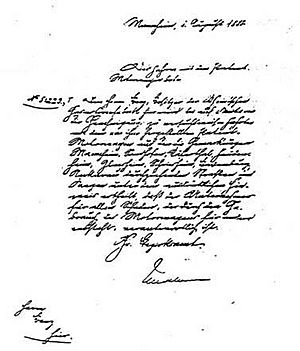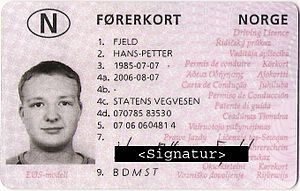Driver's license facts for kids
A driver's license is an official paper or card. It shows that a person is allowed to drive a motorized vehicle. This includes vehicles like a motorcycle, car, truck, or a bus.
Contents
Rules for Driver's Licenses
Different countries have different laws about driver's licenses. In some places, you must pass a driving test to get a license. In other places, you might get a license before you start driving.
For example, in Victoria, Australia, to get a driving license, a person must:
- Be at least 18 years old.
- Live in Victoria.
- Pass an eye test.
- Pass a Hazard Perception Test on a computer.
- Pass a practical Driving Test. This shows you can drive safely and follow road rules.
There are fees for the driving tests. If you pass, there are more fees for the license itself. Many people first get a Learner's permit. This lets them learn to drive with supervision. The first license might be a Probationary Licence. It has some rules about what a driver can do. After four years, a driver can get a full, unrestricted license.
History of Driver's Licenses

Karl Benz invented the modern car. In 1888, he needed special permission to drive his car on public roads. People complained about the noise and smell of his Motorwagen. Before the 1900s, European places gave out driving permissions only when needed.
Mandatory licenses for drivers started on January 1, 1904, in the United Kingdom. Every car owner had to register their vehicle. The youngest age to get a license was 17. This license allowed drivers to go up to 20 mph (32 km/h). Compulsory driving tests began in 1934.
Prussia, part of the German Empire, made licenses mandatory on September 29, 1903. Drivers had to pass a test about how cars work. In 1910, Germany made licensing national. This system of tests and driver's education was then used in other countries.
In 1909, countries started to agree on rules for international driving. This was called the Convention with Respect to the International Circulation of Motor Vehicles. In 1929, the idea of an International Driving Permit was discussed. By 1977, many countries used the term "driving permit" in a convention on road traffic.
Other European countries also started driving tests. Belgium was the last. Until 1977, you could buy a license there without a driving test.
In North America, car accidents increased. Lawmakers looked at French and German rules. On August 1, 1910, New York state had its first licensing law. It was only for professional chauffeurs at first. In July 1913, New Jersey was the first US state to require all drivers to pass a test.
Driver's Licenses as ID
Many countries do not have national identification cards. These include Australia, New Zealand, Canada, the United Kingdom, and the United States. Since many people have driver's licenses, they are often used as proof of identity. Most driver's licenses are the size of a credit card.
Images for kids
-
A driver's license for the moon presented to then NASA Administrator James E. Webb
-
A British driving licence issued in Great Britain after Brexit. UK Driving licences issued by the separate Driver and Vehicle Agency in Northern Ireland are slightly different and do not include either the Union Flag or the Royal Coat of Arms on the right side.
See also
 In Spanish: Autorización para la conducción de vehículos para niños
In Spanish: Autorización para la conducción de vehículos para niños
















